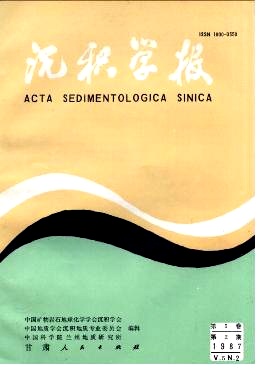ORIGIN OF IRON-BEARING NON-SKELETAL ONCOLITE AND ITS ROLE IN CONCENTRATING IRON IN ORDOVICIAN LIMESTONE, ANHUI PROVINCE
- Received Date: 1985-07-01
- Publish Date: 1987-06-10
Abstract: A kind of iron-bearing non-skeletal oncolites has been found in the Middle and Lower Ordovician grey biomicrite of Kuniutan and Datianba Formations at Shitai, Chao and He counties, Auhui. Beds containing this Kind of oncolites are intercalated between the brownish red or grey-green biomicrite, nodular biomicrite and argillaceous biomicrite. The oncolite content is: 1- 5% or more. The fact that the birdseye structure and desiccation cracks occur on some bed surface indicates that the beds are formed in a shallow subtidal or supratidal oxidizing environment. The sediments bearing the oncolite are distributed in a mud-bank-facies belt which is restricted to the southwestern margin of Ninzhen-Wannan carbonate platforms where are near Huaiyang ancient continent and Jiangnan ancient island which are considered as a source of iron for the oncolite, however, the sediments in the same facies belt but far away from the anceient continent and island develop little ironbearing oncolite. The iron-bearing non-skeletal oncolites are oval grains, 15-20mm in lenghth and the longest up to 32.8mm, consisting of a nucleus of bioclast and concentric laminated crust which is formed by the grown blue-green algae. Two types of oncolite can be recognized depending on the distinction of their microtexture. Type one is columoids consisting of columnar microstromatolites in a radiating arrangement around a nucleus. The second type is colu-strigatoids consisting of laminar-columnar micro stromatolites around a nucleus. Their crust can be distinguished into three parts; inner crust, middle crust ( major curst ) and outer crust. Among them the middle crust is the thickest one. The formation of oncolites underwent several processes: the prepartion of nuclei; the growth of original crust rolling on the bottom) the suspention growth of major crust) the calcification of crust) the growth and abrasion of outer crust) and last the burial and consolidation of oncolites. Based on the thickness of the major crust and the number of algae lamina-minae per unit length, it can be determined that columoids grow faster and suspend longer than the colu-strigatoids. The constituents of the oncolite include calcite, limonite, hematite and cham-osite etc. and calcite is the major composition. The total amuont of ironstone in the oncolite comes to 5.92%. It is four times higher than that of country rocks. Most of iron materials concentrate in the algae laminae and the mucilage of algae with colloidal texture. The iron content ia the laminae has a cyclic change. Based on the distribution of iron it can be suggested that the blue-green algae absorb and precipitate iron materials while they are growing. This process is called concentration of iron in growing period.The iron can also be concentrated around the oncolite in cloud pattern during diagenetic process but it is not important while compared with the former. The oncolite not only contains iron but also contains other metal elements. For example, in the oncolite, Pb = 200ppm, Cu=100ppm, their contents are seven and three times as high as that of country rocks respectively. The evidence mentioned above shows that the growth of algae is of significance in concentrating iron and other metal elements, such as lead and copper, which may result in the formation of sedimentary iron deposits or other metal deposits,
| Citation: | Huang Zhichen, Zhu Sizhao. ORIGIN OF IRON-BEARING NON-SKELETAL ONCOLITE AND ITS ROLE IN CONCENTRATING IRON IN ORDOVICIAN LIMESTONE, ANHUI PROVINCE[J]. Acta Sedimentologica Sinica, 1987, 5(2): 29-38. |






 DownLoad:
DownLoad: